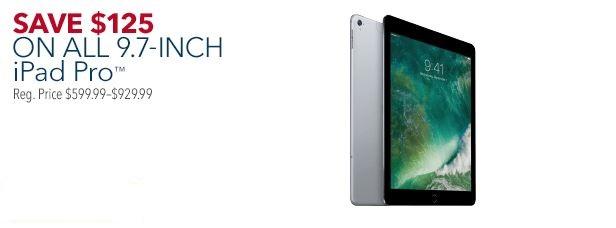
The iPad Pro is the rare Apple tablet getting a discount from retailers this Black Friday.
It’s fair to say that Black Friday, while still popular, is no longer quite the insane orgy of shopping it was even a few years ago. There’s a number of reasons for this — many of which involve the Internet — but the shift in buying habits has been felt in computer sales as well. While there are still a massive number of laptops, desktops and tablets sold on the shopping holiday (and extended weekend), how those systems are paid for, and at what cost, has changed even since Black Friday 2015. Here are a few trends we’ve noticed from studying this year’s deals (and plenty of experience following Black Friday ads over the years).
1. Deals advertised on Apple iPads have dropped.
The one-time tech star of Black Friday has become just another product and combined with Apple’s notorious stinginess when it comes to discounts, we’ve seen far fewer iPad specials this year than ever before. Notably, the newest (relatively speaking) addition to the iPad stable — the iPad Pro — has seen the most sales, perhaps owing both to it being a relatively bright spot in the tablet market and to the competition in the “professional” tablet space from Microsoft’s Surface devices. This isn’t a trend limited to Apple, however, as tablet deals in general have withered as the market has flatlined. One exception is that we’ve seen sales on Samsung’s Galaxy Tabs in nearly every major electronics retailers’ ads. (Another will be discussed below.)
2. Store gift cards in place of price cuts have plummeted.
This trend is directly tied to the one above, as retailers tried to figure out ways to entice people to buy iPads without Apple letting them slash prices on most of them. Their solution was to sell the tablet for the full price, but provide a store gift card as an inducement. It got to the point where stores were extending this strategy beyond iPads to other products (including Apple Macs). If you weren’t interesting in spending another $100 at Target, this wasn’t particularly exciting, but if you could spend the gift card at the store you were purchasing from, it made sense if you were willing to pay full price for the device. With iPad deals losing their luster, this strategy appears to be abandoned by retailers, who have little incentive to provide free gift cards for products that no longer get people to stampede into their stores.
3. The expected wave of $100 PCs is more like a ripple.
With the rise of Chromebooks and Microsoft’s decision to drop the price of Windows licensing on lower-cost devices, pundits have expected a flood of budget desktops and laptops that would cost no more than a Benjamin. While we’ve definitely seen some systems floating around the century mark in price, they are fewer and far between than predicted and are often “doorbusters” available at a set time in limited quantities. We may have seen the pricing floor for bargain PCs, whether due to manufacturing costs or buyers’ reluctance to purchase a computer with cut-down specs or a combination of factors. You’re frankly more likely to see a better performance-price “deal” on a mid-range system, which may cost a couple of hundred dollars more but provide a lot more power for under $500.
4. Amazon wants to destroy all cheap tablet sales with its $33.33 Kindle Fire deal.
Amazon has not only wrecked the mainstream Android tablet market with its hugely successful Kindle Fire slates, but it’s also obliterating whatever market was left over for the sub-$50 no-name tablets that pop up in many Black Friday ads. You know the ones: those starter tablets for kids purchased knowing they probably won’t last until the next Black Friday. The massive online retailer is selling its cheapest tablet, the 7-inch Kindle Fire, for just $33.33 for Black Friday, about 30 percent lower than usual. Even worse for the competition is that Amazon is also allowing other retailers to sell it for the same price, making it a very easy impulse gift for someone who doesn’t mind a slower device with lackluster battery life (i.e., children).
5. Sellers continue to use various tactics to inflate the amount you’re saving on a Black Friday PC deal.
Each year, buyers are warned that Black Friday “deals” aren’t always what they appear to be. Retailers use a variety of strategies to make sales look better than they are, and that is no more apparent than with electronics sales. Always do a web search for a system you are considering buying to determine what the current price is. Sometimes Black Friday discounts are based on the original price, even if the price that day has already been reduced from the original. It still may be worth purchasing, but the sale could be less eye-popping than it appears to be. Also be on the lookout for enticing pricing for what turns out to be a refurbished system. Buying refurbished shouldn’t be much riskier than buying new, but you don’t want to jump on a great deal only to realize later it’s not for a new product.


